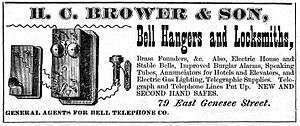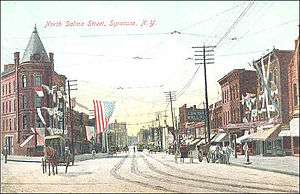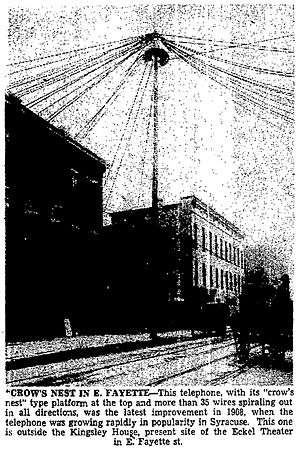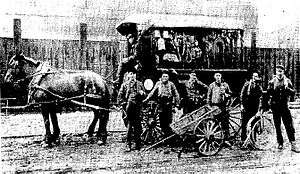Syracuse Telephonic Exchange
| Telecommunications | |
| Industry | Telecommunications |
| Genre | Telephone exchanges |
| Fate | New York Telephone Company was a consolidation of all private telephone exchanges in New York State |
| Founded | 1880 |
| Headquarters | Syracuse, New York, United States |
Area served | United States |
Key people | Frederick C. Brower, Hiram C. Brower, Mathew J. Myers and D. L. Pyke |
| Services | Telephone services |
The Syracuse Telephonic Exchange was founded after Frederick C. Brower introduced the Bell telephone to Syracuse, New York in 1878.[1] He had seen the device exhibited at the Philadelphia Exposition of 1876 and secured Central New York rights from the Bell system.[2] His father, Hiram C. Brower, was credited with installing the first "speaking tubes" in Syracuse and also the first enunciators and began the first telephone exchange which had about 1,000 subscribers.[3]
During 1879, Mathew J. Myers, who operated a local telegraph and messenger service in the city, opened an exchange in the tower of the Gridley Building after sub-leasing the rights from Brower.[4] D. L. Pyke, superintendent of Western Union, opened a rival exchange in the Wieting Block in Downtown Syracuse.[4]
The two exchanges merged in 1880, with a total of 35 subscribers and the new establishment was named the Syracuse Telephonic Exchange.[4] Among the services Pyke offered his subscribers was an opportunity to "listen by telephone to all the concerts at the Wieting Opera House."[4]
History
In 1876, Frederick C. Brower journeyed to Philadelphia to see the Centennial Exposition, and when he returned home he brought the telephone with him. While at the exposition, Brower watched Alexander Graham Bell's demonstration of telephony and was impressed to such an extent, that he applied for, and received a license to develop and operate a telephone system[5] for New York State (north of the Pennsylvania state line).[6]
Brower phone lines
Brower brought back two telephone "instruments" from the exposition to connect his home and shop.[5] He installed the first phone line in the city in between his shop on Crouse Avenue and home at Clinton and Jefferson Streets.[7]
The sight of Brower's telephone wire "crossing barns and tree tops," aroused the humor and curiosity of Syracusans. Brower demonstrated the device at the Wieting Opera House in Clinton Square on February 28, 1878. Although human voices "defied transmission," band music played in Auburn and transmitted by telegraph wire could be heard just fine in Syracuse. The demonstration generated a "huge amount of interest in the city."[4]
According to local newspapers at the time; "the phenomena was met with mixed criticism, some terming it a miracle, others calling it haunted."[7]
The night operators of the Western Union Telegraph Company were not surprised by the technology. They had never heard of Bell nor his "bug" as they called his inspiration, but they had already heard stories of a fellow night operator, John Bierbardt, who would often hear a "fiddle playing" in Oswego, some 36 miles (58 km) away, and had "sung and danced to the music" as early as 1873. The operators had learned through accident that a certain adjustment of the connecting wire made the sound of the violin held close to the operating table in Oswego "very distinct" when an ear was pressed on the connected table in the Syracuse office. Sometimes the strains of music were "loud enough to fill the room with melody."[8]
The new invention was met with much skepticism by the press. A local news agency reported that; "A few months ago the public was startled by the intelligence that a new invention in telegraphy had developed the fact that persons could be heard and people could actually converse with each other by telegraph and even musical sounds could be conveyed from one city to another. The statement was received with wonder if not incredulity by the press and public. But little has been heard from it for some time. It seems however, from an article we find in the Troy Times that the invention has not been abandoned but that efforts are in progress to bring it to practical perfection with strong hopes of eventual success."[8]

An advertisement in Boyd's Syracuse City Directory in 1879, showed that H. C. Brower & Son were "bell hangers and locksmiths" as well as brass founders. They specialized in electric house and stable bells, improved burglar alarms, safes, speaking tubes, annunciators for hotels and elevators, electric gas lights and telegraphic supplies. They also noted they were general agents for Bell Telephone Company and they installed telegraph and telephone lines. Their shop was located at 79 East Genesee Street.[9]
Bell license
Making use of his Bell license, Brower offered lease of the instruments for US$40 per year, plus another US$3 for magnetos.[4] Though his son introduced the telephone to Syracuse, Hiram C. Brower, through the family business, was credited with installing the first "speaking tubes" in Syracuse and also the first enunciators. He sold his enterprise to the Bell Company after obtaining about 1,000 subscribers.[3]
Hamilton S. White, head of the fire department, installed a line from fire headquarters to his home. Many businesses joined the exchange, including the Robert Gere Bank and lawyer, George K. Collins.[4] Soon after, the first three-way telephone hookup was made by William A. Sweet, founder of the Straight Line Engine Company, who strung wires over housetops and from tree to tree in order to connect his shop on South West Street with another shop on Geddes Street and his home on James Street. Many "men of vision" followed suit, and by 1879, there were 208 names listed in the local city directory.[7]
Gridley block

In 1879, Mathew J. Myers, who operated a local telegraph and messenger service in the city, opened an exchange in the tower of the Gridley Building after sub-leasing the rights from Brower. Not long after he set up a second exchange in the old Onondaga County Savings Bank Building in the Gridley Block.[5] Myers employed a male operator and had 16 subscribers. Mrs. S. Gurney Lapham "put through the first call."[4]
Syracuse telephonic exchange
D. L. Pyke, superintendent of Western Union in Syracuse, opened a rival exchange in the Wieting Block in Downtown Syracuse. Among his customers were Judge Hiscock and George J. Whelan, founder of the United Cigar Stores.[4]

Boyd's Syracuse City Directory in 1879 noted that the Syracuse Telephonic Exchange was located at 24 Onondaga County Savings Bank Building. George Barnes was president, M. J. Myers was treasurer, M. Jervis Myers was manager and W. H. Girvin was superintendent. Mrs. Louisa A. Church was the night operator and Andrew McGann was day operator. The service was operated by American District Telegraph Company and they were "open day or night." The firm had branches at the Post Office, Plumb & Powers' Drug Store and Williams Bros' News Room and advertised in that "messengers and hacks furnished instantly."[9]
The two exchanges headed by Myers and Pyke, merged in 1880, with a total of 36 subscribers and was named the Syracuse Telephonic Exchange.[4] Pyke's central office moved to the Gridley Block.[5] Among the services Pyke offered his subscribers was an opportunity to "listen by telephone to all the concerts at the Wieting Opera House."[4]
_coming_thru_Washington_Street%2C_Syracuse%2C_N.Y..jpg)
Among the officers of the new company were; George Barnes, president; Walter H. Girvin, superintendent, Matthew Myers, treasurer; and Jervis Myers, manager.[5] The first telephone directory, published at about the same time, listed 10 state, county and city phones, 36 residential subscribers and 150 businesses.[4]
Miss Rose E. Richardson was one of the first operators at the exchange. Four messenger boys "raced through Syracuse streets" to call any of the 36 customers to the telephone and to carry messages. The majority of telephones were installed in the police and fire department headquarters or in hotels. In the outskirts of the city, phones were even rarer and Fayetteville had only one device.[5]
Power for the exchange was supplied by galvanic batteries which required constant attention and had to be filled with water daily.[5]
Central New York telephone and telegraph company
The Syracuse Telephonic Exchange was using the Edison instruments sold by the Western Union Telegraph Company. At the same time, the Bell Telephone interests were building a state-wide service, "as an aid to the sale of Bell machines." On June 1, 1887, the Central New York Telephone and Telegraph Company of Utica bought the local exchange. The latter had been organized five years earlier after a merger of the Mohawk Valley Company of Rome and Utica and other exchanges in Herkimer, Watertown, Ogdensburg and Utica. The new combine covered 10 counties and the exchange in the Wieting Block listed 350 subscribers.[4]

The company built a new office and moved back to the Wieting Block in 1887. At that time there were 250 telephones served from a switchboard which had positions for eight operators for local calls and two for toll calls. Operators tested the lines by ringing every customer each morning at 7:00 am and bidding them a cheery "good morning."[4] If a customer failed to answer, it was assumed his telephone had "gone out of order during the night" and a repairman was sent to fix it by 7:30 am.[10]
While the promptness of service pleased businessmen who were in the office by 7:00 am, the early hour irked people who were at home so much so that telephone service to private residences didn't take off until 1904, when other systems of equipment testing were devised.[10]
The telephone office was also the central point for a fire alarm system and the operators would announce the fires to the fire department through a direct-line telephone hookup.[5]
During the first year of business, the company added 350 telephones. Telephone service spread under the management of Charles A. Nicholson, Warren H. Girvin and Walter W. Nicholson of 515 Allen Street.[4]
By 1894, the company address was listed in Andrew Boyd's Syracuse City Directory as 78 Wieting Block.[11]
Downtown Syracuse became a "wilderness" of "cross-armed" telephone poles and the network of open wires throughout the city became more and more complex. There were poles 90 feet (27 m) high on Salina Street, each with 10 to 20 cross-arms loaded to capacity with wire. There were numerous "fights" about stringing wire throughout the city and a "long city squabble" preceded the award of a cable subway franchise to install the wires underground.[4] "Agitation for the removal of the poles" led to an application in 1897 for the cable subway system[4] and work was begun in March 1898.[5]

On January 26, 1899, the new building at 311 Montgomery Street was ready for occupation. A new switchboard was opened and was equipped for 2,100 customer lines and 200 trunk lines. By this time, there were 91 employees; including 37 operators. The daily average number of calls made in Syracuse was 21,200.[5]
By March 1, 1904, the company had already outgrown their new building because of the growth in service. To prepare for future growth and demand, the company changed all residence service from message rate to flat rate and developed plans to construct a new building, which was begun in July 1904, at 321 Montgomery Street.[5]
Meanwhile, the Central New York Telephone and Telegraph Company was growing by leaps and bounds. On November 10, 1905, the accounting department moved into the new building. Records were shipped from Utica by steamboat on the Erie Canal; a mode of transportation that was quicker and less expensive than the railroad.[5]

On January 13, 1906, the central office opened with what was considered the largest switchboard in the world, serving 7,000 customers. Very soon, this was also inadequate. The building was supposed to handle telephone growth for 20 years. Instead, before two years had passed, the company found itself in need of more space. An addition was made to the building in 1908 which was almost as large as the original building.[5]
At that time there were still two major rivals to the company who called Syracuse headquarters. One was the Empire State Telephone and Telegraph Company, which served seven counties; and the other was New York and Pennsylvania Telephone and Telegraph, which operated in the "Southern Tier."[4]
Syracuse telephone company
July 1, 1899, marked the organization of the independent Syracuse Telephone Company with J. F. Stockwell as general manager. The company opened a central office in the Snow Building.[5]
During 1905, the rival company was reorganized as the Onondaga Independent Telephone Company and moved into the "old brick Crouse stables" at 207 South State Street, where they installed a "modern central office."[5]
New York telephone company

In 1909, the New York Telephone Company was formed from the Empire State Telephone Company, the New York & Pennsylvania Telephone Company, the Hudson River Telephone Company and the Central New York Telephone and Telegraph Company. Syracuse became division headquarters for the new organization and W. W. Nicholson was named general manager.[5] The New York Telephone Company had moved into offices in Montgomery Street, formerly owned by the Central New York Telephone and Telegraph Company, which at the time were "the largest central office in the world" and were still in use in 1939. The "spacious headquarters" resulted in the company's choice of Syracuse as auditing center and divisional headquarters.[4]
In 1911 the New York Telephone Company purchased the Onondaga Independent Telephone Company and consolidated the two companies in Syracuse in June 1912. The Independent became the James Exchange and the New York Telephone Company served the Warren Exchange. During this period, more than 1,800 telephones were added to the list of accounts in service.[4]
It was estimated that during the five years before World War I, the telephone company removed 2,626 poles and 4,600 cross arms, bearing 775 miles (1,247 km) of copper wire.[4]
First dial office
On June 29, 1922, Syracuse's first dial telephone office was opened with the designation "Syracuse 2" and more than 4,700 telephones. The city became the first multi-office point to have dial service.[5] By February 1926, the second dial office, "Syracuse 3," was implemented. At that same time, the James Exchange was retired.[5]
The company had 1,500 employees by 1928 and served 43,000 telephones in the 90-square-mile (230 km2) Syracuse area. The building at State and Fayette Streets was opened, with equipment for 100,000 dial telephones.[5] In succeeding months, additional central offices went into service, making the city the largest city to have 100 percent dial service.[5] Buildings to house the additional dial offices were constructed at 4725 South Salina Street and in Draper Avenue.[5]
In 1930, there were 52,000 telephones in Syracuse. Growth stopped by the end of the ensuing decade there were 50,000 telephones, a loss of 2,000 telephones. During World War II, telephone activity was extremely limited and service was necessarily curtailed in the interests of defense[5]
Mid-century growth
In 1946, the postwar growth caused the company to launch the largest program of telephone expansion and improvement in its history.[5] Mobile service was also established in 1946 for customers who wanted telephones in their cars.[5]
An addition was made to the "9" central office to take care of 5,000 of the 6,500 individuals on the waiting list for telephone service in 1947. That same year, the switchboard was enlarged to handle the "vast" increase in long distance calls. Nearly 50,000 toll calls were handled daily at the switchboard.[5]
Between 1943 and 1947, the number of local calls made each day in the city jumped from an average of 368,000 to 528,000 and another 9,000 telephones were added in 1947, bringing the total to 82,000. New telephone facilities were constructed in Mattydale and Eastwood after World War II and new dial offices were added.[5]
Growth continued unabated and by 1949, a total of 13,000 telephones were added in Syracuse and more than 50 miles (80 km) of telephone cable was also installed.[5]
During March 1950, Syracuse's 100,000th telephone was installed. In eleven years, the number of telephones in the city had doubled. That same year, the Syracuse Metropolitan Plan was introduced with toll-free calling to Cardiff, LaFayette and Pompey. East Syracuse and Minoa received dial telephone service.[5]
Demand had declined somewhat by 1951. The company added only 6,300 telephones that year and the waiting list had been reduced to a small number.[5] Advertisements for some of the first "non black" telephones came in 1951 in either white or beige.[10]
By the mid-1950s, local telephone customers could dial, toll-free, more than 125,000 telephones direct. A new toll-switching center was installed in the telephone building at 219 South State Street, where long distance calls were switched automatically to points all over the country.[5]
Cable subway projects continued throughout the years and by 1955 there were several under construction including one along East Genesee Street to provide additional service to eastern Syracuse and the Dewitt area.[5] By 1962, the first touch-tone phones arrived.[10]
Later years
In 1971, New York Telephone Company opened its new headquarters in Syracuse at 300 East Washington Street. They continued to utilize the State Street location for electronic switching equipment. The Montgomery Street location was acquired by the county for use as a museum.[12]
By 1981, the company served 185,000 customers in the Central New York area and 6.5 million statewide. Almost a million calls originated each day compared to 7,000 in 1917.[12]
The former New York Telephone Company was renamed to NYNEX in 1984 when the Bell system was broken up and local Bell companies were merged into seven "Regional Bell Operating Companies" (RBOCs), also known as "Baby Bells."[13]
In 1997, the Bell system consolidated again into five companies and NYNEX became part of the Bell Atlantic system which eventually merged into Verizon.[13]
References
- ↑ "F. C. Brower's Auto May Predate Duryea". Syracuse Herald-Journal. Syracuse, New York. September 26, 1954.
- ↑ "Automobile Spurred Growth of Central N.Y. Industry". Farber and Associates, LLC 2009–2011. January 10, 1984.
- 1 2 "H. C. Brower Dies. In Same Place of Business 64 Years". Syracuse Journal. Syracuse, New York. November 20, 1911.
- 1 2 3 4 5 6 7 8 9 10 11 12 13 14 15 16 17 18 19 20 21 "Phones Here Soon After Invention". Syracuse Journal. Syracuse, New York. March 20, 1939.
- 1 2 3 4 5 6 7 8 9 10 11 12 13 14 15 16 17 18 19 20 21 22 23 24 25 26 27 28 29 30 31 "Trip to Philadelphia in '76 Led to City's Vast Phone System". The Post-Standard. Syracuse, New York. September 13, 1953.
- ↑ "F. C. Brower, 80, Telephone Pioneer, Dead". Syracuse Herald. Syracuse, New York. July 15, 1931.
- 1 2 3 "Telephone Exchange Joins Bell System". The Post-Standard. Syracuse, New York. May 25, 1955.
- 1 2 Alvord, Thomas G. (February 4, 1923). "Phone and Radio Forecast in Odd Actions of Wire". Syracuse Herald. Syracuse, New York.
- 1 2 Boyd's Syracuse Boyd's City Directory 1879. Andrew Boyd, 1879.
- 1 2 3 4 "Telephones Had Halting History". The Post-Standard. Syracuse, New York. September 20, 1979.
- ↑ Boyd's Syracuse Boyd's City Directory 1894. Andrew Boyd, 1894.
- 1 2 Richard Palmer and Fred Heyman (November 28, 1981). "The Changing Face of Syracuse". Syracuse Herald-Journal. Syracuse, New York.
- 1 2 "History of the Bells". TeleTruth, 2011.